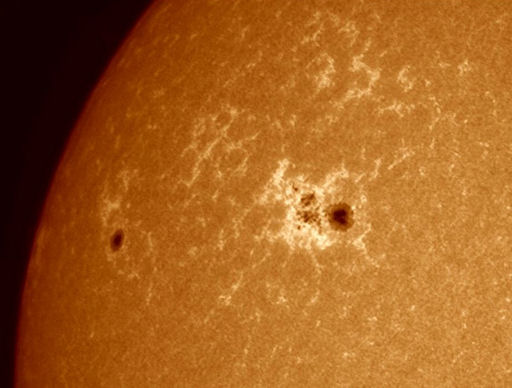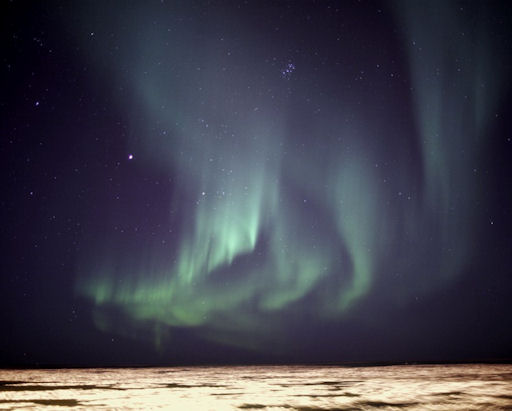CHANCE OF FLARES: NOAA forecasters estimate a 60% chance of M-class solar flares and a 10% chance of X-flares during the next 24 hours. The most likely source of any eruption is big sunspot AR1598. Solar flare alerts: text, voice.
MAGNETIC FROTH: Sunspot AR1598 has quieted down since unleashing an X1-class solar flare on Oct. 23rd. It might be the calm before the storm. The sunspot is still large and apparently potent, as shown in this image captured by amateur astronomer Sergio Castillo of Inglewood,California:
Castillo used a telescope capped with a "Calcium K" filter tuned to the light of ionized calcium atoms in the sun's lower atmosphere. Calcium K filters highlight the bright magnetic froth that sometimes forms around a sunspot's dark core. AR1598 is very frothy indeed.
Magnetic froth does not necessarily herald an explosion, but it does guarantee a photogenic sunspot. Scan the gallery for the latest images:
Realtime Space Weather Photo Gallery
ARCTIC AURORAS: On the North Slope of Alaska, the Beaufort Sea is beginning to freeze as northern winer approaches. Last night, Northern Lights illuminated the phase change:
"I finally caught some auroras over the hardening sea," says photographer Greg Syverson. "This was a 3 second exposure taken with my Canon 5D digital camera set at 3200asa."
There was no geomagnetic storm last night, but because the Beaufort Sea is above the Arctic Circle, auroras can appear there even when Earth's magnetic field is relatively quiet. NOAA forecasters predict a scant 5% chance of geomagnetic storms tonight. Nevertheless, Arctic ice might still be illuminated by Northern Lights. Browse the gallery for updated images from the north:

![]()
Solar wind
speed: 352.4 km/sec
density: 2.2 protons/cm3
explanation | more data
Updated: Today at 1337 UT
![]()
X-ray Solar Flares
6-hr max: C1 0734 UT Oct25
24-hr: C2 0422 UT Oct25
explanation | more data
Updated: Today at: 1300 UT
![]()
![]()
![]()
Daily Sun: 25 Oct 12
![]()
![]()
Sunspot 1598 poses a threat for M- and X-class solar flares. Credit: SDO/HMI
![]()
![]()
![]()
Sunspot number: 78
What is the sunspot number?
Updated 25 Oct 2012
Spotless Days
Current Stretch: 0 days
2012 total: 0 days (0%)
2011 total: 2 days (<1%)
2010 total: 51 days (14%)
2009 total: 260 days (71%)
Since 2004: 821 days
Typical Solar Min: 486 days
Update 25 Oct 2012
The Radio Sun
10.7 cm flux: 136 sfu
explanation | more data
Updated 25 Oct 2012
![]()
![]()
![]()
Current Auroral Oval:
![]()
Switch to: Europe, USA, New Zealand, Antarctica
Credit: NOAA/POES
![]()
![]()
![]()
Planetary K-index
Now: Kp= 1 quiet
24-hr max: Kp= 1 quiet
explanation | more data
![]()
Interplanetary Mag. Field
Btotal: 5.1 nT
Bz: 3.3 nT north
explanation | more data
Updated: Today at 1337 UT
![]()
![]()
![]()
Coronal Holes: 25 Oct 12
![]()
![]()
There are no large coronal holes on the Earthside of the sun. Credit: SDO/AIA.






